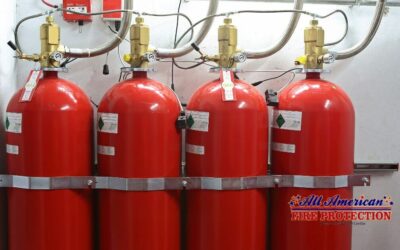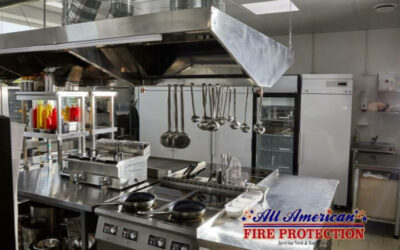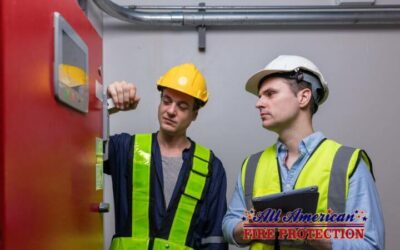Understanding Fire Suppression Systems
Fire Suppression Systems are pivotal to safety measures in businesses, particularly those that handle materials or engage in processes with a high fire risk. Entrusting this monumental responsibility to the experts at All American Fire Protection, who specialize in Fire Suppression Systems, is a strategic move toward safeguarding assets and lives. These systems are designed as comprehensive solutions, ready to act swiftly and limit damage in the event of a fire. Comprising various elements such as fire detectors, alarms, control panels, and fire extinguishing agents, these systems work collectively to detect early signs of fire, raise alerts, and ultimately suppress the fire. Grasping the workings of these systems is crucial for ensuring their optimal performance. Equally significant is their regular inspection to guarantee they operate at their peak when needed. This article will delve into the reasons for regular inspections, the inspection process, and touch on some legal and financial considerations.
Key Components and Their Roles
Each Fire Suppression System is made up of several essential components, each with a distinct role in the detection and suppression of fires.
- Fire Detectors: These devices are critical for early fire detection, enabling immediate action. Fire detectors can sense heat, smoke, or flame and activate the suppression system.
- Control Panel: Acting as the system’s ‘brain,’ it receives signals from detectors and kickstarts the fire response process. It coordinates the system’s components and can send alerts to designated personnel or fire departments.
- Alarm : Alarms are triggered upon receiving a signal from the control panel, alerting building occupants to the presence of a fire and prompting an immediate evacuation.
- Fire Suppression Agent : This could be water, foam, dry chemicals, carbon dioxide, or clean agents, tailored to the type of fire risk and the environment. The agent is released to control and suppress the fire.
- Delivery Systems: These are mechanisms that efficiently distribute the suppression agent to the fire source. Examples include sprinklers, nozzles, and piping.
A thorough understanding of these components will facilitate a better comprehension of the subsequent sections that discuss the importance, process, and implications of regular fire suppression system inspections.
Significance of Regular Fire Suppression System Inspections
Regular inspections of your Fire Suppression Systems are a critical safeguard for your business. They not only protect your premises but also ensure you meet legal and insurance obligations. The benefits of these inspections are manifold:
- They guarantee the optimal operation of the system and its components, ensuring readiness to combat fire emergencies effectively.
- They help detect potential problems such as leaks or malfunctioning parts that could impede the system’s performance during a fire.
- They ensure compliance with local fire codes and standards, which mandate regular inspections and maintenance across different jurisdictions.
- They provide certified documentation of system maintenance, a requirement for insurance and legal purposes.
Keeping Fire Suppression Systems in top-notch condition is essential for the effective protection of your business, employees, clients, and assets. The following sections delve deeper into these aspects.
Maintaining System Readiness
The readiness of your Fire Suppression System is crucial in safeguarding lives, properties, and ensuring the continuity of your business. Regular inspections are instrumental in maintaining this state of readiness.
The effectiveness of the system hinges on each component functioning as it should. For example, fire detectors must be sensitive and responsive, the control panel must accurately process signals, and the delivery system must disperse the suppression agent effectively when triggered.
A comprehensive inspection routine includes tests to check if activation triggers like heat or smoke detectors respond promptly under simulated conditions. It also verifies that control panels interpret these signals correctly and initiate the appropriate response, such as sounding the alarm and releasing the fire suppression agent.
Moreover, regular inspections facilitate the timely identification and replacement of worn or outdated components like sprinklers or detectors that could potentially compromise the system’s efficiency.
In short, maintaining system readiness through regular inspections ensures that your fire suppression system can respond immediately and effectively during a fire emergency. This proactive approach minimizes potential fire damage and maximizes safety.
Detection of Potential System Issues
Fire Suppression Systems, despite their robust design, are not immune to faults. These faults can arise from a variety of sources, including routine wear and tear, neglect, or environmental conditions. Regular inspections play a pivotal role in identifying these issues early on, ensuring the system remains effective, efficient, and ready to respond to fire emergencies.
The types of issues that can arise are diverse. They may range from minor leaks in the delivery system, malfunctioning fire detectors, outdated control panels, to blocked nozzles. Consider a minor leak, for example. While it may seem insignificant, if overlooked, it can result in insufficient pressure in the system, thereby compromising its effectiveness during a fire emergency.
Moreover, certain components of the fire suppression system may degrade over time or with use. Sensors may lose their sensitivity, seals may erode, suppression agents may expire, or the software in the control panel may require updates. Regular inspections are instrumental in identifying these issues early, enabling timely intervention and preventing the escalation of these issues, thereby safeguarding your property and its occupants.
In essence, the proactive identification of potential system issues through regular inspections helps maintain system performance, minimizes unexpected downtime, and enhances overall safety. The importance of early detection through regular inspections is paramount.
Fire Suppression System Inspection Process
The inspection of a Fire Suppression System is a detailed and comprehensive process that demands a high level of precision and attention to detail. This process is designed to ensure that the system is primed and ready to respond effectively to fire emergencies. It involves several key steps, including a meticulous examination of various components, conducting system functionality tests, and a thorough review of performance records.
Each of these steps plays a crucial role in identifying potential system issues and ensuring that the system is compliant with safety standards. The subsequent sections will provide a more in-depth look into the inspection procedures and highlight the integral role of certified inspectors in this process.
Inspection Procedures
The process of inspecting a Fire Suppression System is a detailed one, crafted to ensure a comprehensive evaluation of the system’s operational status. Here’s a snapshot of the steps involved:
1. Physical Inspection: This step involves a visual assessment of the entire system, looking for signs of damage, wear, leakage, blockages, and rust, among other issues.
2. Component Testing: This phase tests each part of the system – detectors, control panels, alarms, sprinklers, and suppressants – to confirm they are operating as intended.
3. Performance History Review: This involves reviewing past performance records of the system during tests or actual fire incidents to identify any recurring issues.
4. Installation Review: This step ensures the system’s installation aligns with the relevant codes and standards, including the correct placement and alignment of detection and suppression devices.
5. Alarm Response Validation: This phase tests the alarm response to ensure it triggers as expected and alerts the necessary individuals during a fire.
6. System Integrity Verification: The final step involves checking the system’s pressure levels, electrical connections, and signal transmission capabilities to assess the overall system integrity.
This meticulous process ensures every facet of the suppression system is thoroughly evaluated, facilitating the detection and resolution of issues, and promoting improved fire safety.
The Role of Certified Inspectors
Certified inspectors are the linchpin in maintaining the effectiveness of Fire Suppression Systems. These experts have received rigorous training and have a deep understanding of fire codes, system components, and cutting-edge inspection procedures and technologies.
Their responsibilities include conducting exhaustive examinations of all system components, performing regular tests to confirm system readiness, and pinpointing and addressing potential system issues. They also ensure the system’s installation and maintenance align with current fire codes and safety standards.
Additionally, after an inspection, a certified inspector will provide a comprehensive report detailing the system’s condition, any identified potential issues, and suggestions for necessary repairs or upgrades.
By engaging a certified inspector for regular inspections, businesses can have peace of mind knowing their fire suppression systems are being assessed by a competent professional, thereby enhancing fire safety and business continuity.
Legal and Regulatory Aspects
The importance of regular fire suppression system inspections extends beyond the realm of safety. These inspections are also integral to meeting legal and regulatory requirements. Businesses are obligated by law to uphold certain standards in maintaining their fire suppression systems. In the subsequent sections, we will explore the significance of complying with fire codes and the potential legal ramifications associated with regular inspections of fire suppression systems.
Adhering to Fire Codes
Compliance with fire codes is a fundamental requirement for businesses. These codes, which encompass regulations related to construction, process control, fire division separation, and emergency evacuation plans, are designed to minimize fire hazards. By adhering to these codes, businesses not only ensure safety but also sidestep potential legal issues.
Fire codes provide specific standards for the installation, maintenance, and operation of fire suppression systems. Certified inspectors, well-versed in these codes, can confirm that your fire suppression system is in compliance with the law. This not only enhances the system’s effectiveness but also safeguards your premises and its occupants.
Fire codes are often based on nationally recognized standards, such as those set forth by the National Fire Protection Association (NFPA). These standards govern various aspects of fire safety, including the appropriate suppression systems for different risks, the maintenance and testing of these systems, and the qualifications required for personnel performing these tasks.
Non-compliance with fire codes can lead to penalties, increased insurance premiums, and even a temporary halt in operations until compliance is restored. Regular inspections can guide businesses in navigating and adhering to these codes, thereby cultivating a safety culture that safeguards lives, property, and business continuity.
Potential Legal Implications
The legal landscape surrounding fire suppression systems is not to be taken lightly. Businesses that fail to uphold the standards of a well-maintained system may find themselves facing severe repercussions. Fire codes, for instance, are more than mere suggestions; they are laws that carry weight and enforceability. Falling short of these regulations can lead to hefty fines or even sanctions.
The potential legal ramifications extend beyond monetary penalties. In instances where neglect leads to harm or property damage, criminal liability could be a stark reality. Moreover, if a fire breaks out and an inadequately maintained fire suppression system is to blame, the business could be subject to civil lawsuits. The resulting compensation for personal injuries or loss of life could be financially devastating.
Insurance coverage is another critical consideration. A business that fails to meet local fire codes may find its insurance coverage in jeopardy. In the unfortunate event of a fire, the insurance company may reduce or outright deny a claim if the business has not maintained the required standards for its fire suppression system.
Regular inspections of fire suppression systems are a proactive measure to avoid these legal pitfalls. They ensure compliance with fire safety regulations and protect a business’s reputation, demonstrating a commitment to the safety of the premises, employees, and visitors.
Financial Considerations of Regular Inspections
While the primary focus of fire suppression system inspections is undoubtedly safety, the financial implications intertwined with these procedures cannot be overlooked. Grasping the costs and potential financial benefits of regular inspections can empower business owners to make informed decisions.
The following sections delve into the financial aspects of these inspections, covering both the immediate costs and the long-term financial benefits. Regular inspections of fire suppression systems, while an upfront investment, can yield significant savings in the long run, mitigating potential fines, lawsuits, and insurance complications.
Cost of Inspections
The financial aspect of fire suppression system inspections is multifaceted, influenced by a variety of elements. The size of the facility, the intricacy of the installed fire suppression system, and the specific guidelines set by local authorities all contribute to the overall cost. It’s easy to view these inspections as an added expenditure, but it’s essential to recognize them as a crucial component of a business’s safety strategy.
The inspection costs typically encompass the certified inspectors’ professional fees and the equipment utilized during the process. Additionally, any necessary system maintenance or repairs identified during the inspection may incur extra charges.
While these expenses may seem to accumulate, it’s vital to understand that they pale in comparison to the potential financial consequences of neglecting regular inspections. These could include penalties for non-adherence to fire codes, legal costs, or damages from a fire due to a malfunctioning suppression system.
Therefore, the decision to invest in regular fire suppression system inspections is not just a safety measure but a strategic business move aimed at risk reduction. The subsequent section will explore the long-term financial advantages of consistent inspections.
Long-term Cost Benefits of Regular Inspections
While the immediate costs of regular fire suppression system inspections may seem daunting, it’s important to consider the numerous long-term financial advantages.
To begin with, routine inspections can detect potential issues before they become major problems, thereby saving on costly repairs or system replacements down the line. Regular maintenance extends the system’s lifespan, ensuring it operates at peak efficiency for an extended period. This reduces the need for frequent system upgrades or replacements, leading to significant savings over time.
Moreover, adhering to fire codes through consistent inspections can help avert potential fines or legal complications stemming from non-compliance. Legal disputes arising from inadequate preventive measures can be financially draining due to settlements, legal fees, and potential damage to the business’s reputation.
Furthermore, many insurance companies offer reduced premiums to businesses that demonstrate a commitment to safety through regular inspections and maintenance. This can result in substantial insurance cost savings in the long run.
Most importantly, an effective fire suppression system can prevent or significantly reduce the damage caused by a fire. While it’s impossible to quantify the potential loss of life, the financial impact of property damage, business disruption, and loss of valuable assets can be catastrophic.
Thus, despite the initial costs associated with regular inspections, the long-term savings, enhanced protection, and peace of mind they offer make them a sound investment for any business.






